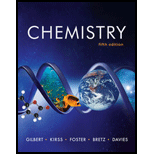
Interpretation: The reaction for the decomposition of Nitrous oxide into Nitrogen and Oxygen and the graph representing the change in the concentration of the reactants and products is given. The curve representing the concentration of
Concept introduction: The branch of science that deals with the rate of
To determine: The curve representing the concentration of
Answer to Problem 13.1VP
Solution
The green curve corresponds to the concentration of
Explanation of Solution
Explanation
The graph for change in the concentration of reactants and products is given as,

Figure 1
The given reaction is,
During a chemical reaction the concentration of reactant keeps on decreasing while the concentration of products keeps on increasing. Therefore, in the above graph green curve is showing a decrease in concentration with time, it means it corresponds to the reactant and in the given equation
As blue and red curve show an increase in the concentration, therefore they correspond to the products. The concentration in blue curve is twice the concentration in red curve. Now, as the concentration of
Conclusion
The curve showing decrease in concentration corresponds to the reactant while the curve showing increase in concentration corresponds to the products.
Want to see more full solutions like this?
Chapter 13 Solutions
Smartwork5 Printed Access Card for Use with Chemistry: The Science in Context 5th Edition (SmartWork Access Printed Access Card)
 ChemistryChemistryISBN:9781305957404Author:Steven S. Zumdahl, Susan A. Zumdahl, Donald J. DeCostePublisher:Cengage Learning
ChemistryChemistryISBN:9781305957404Author:Steven S. Zumdahl, Susan A. Zumdahl, Donald J. DeCostePublisher:Cengage Learning ChemistryChemistryISBN:9781259911156Author:Raymond Chang Dr., Jason Overby ProfessorPublisher:McGraw-Hill Education
ChemistryChemistryISBN:9781259911156Author:Raymond Chang Dr., Jason Overby ProfessorPublisher:McGraw-Hill Education Principles of Instrumental AnalysisChemistryISBN:9781305577213Author:Douglas A. Skoog, F. James Holler, Stanley R. CrouchPublisher:Cengage Learning
Principles of Instrumental AnalysisChemistryISBN:9781305577213Author:Douglas A. Skoog, F. James Holler, Stanley R. CrouchPublisher:Cengage Learning Organic ChemistryChemistryISBN:9780078021558Author:Janice Gorzynski Smith Dr.Publisher:McGraw-Hill Education
Organic ChemistryChemistryISBN:9780078021558Author:Janice Gorzynski Smith Dr.Publisher:McGraw-Hill Education Chemistry: Principles and ReactionsChemistryISBN:9781305079373Author:William L. Masterton, Cecile N. HurleyPublisher:Cengage Learning
Chemistry: Principles and ReactionsChemistryISBN:9781305079373Author:William L. Masterton, Cecile N. HurleyPublisher:Cengage Learning Elementary Principles of Chemical Processes, Bind...ChemistryISBN:9781118431221Author:Richard M. Felder, Ronald W. Rousseau, Lisa G. BullardPublisher:WILEY
Elementary Principles of Chemical Processes, Bind...ChemistryISBN:9781118431221Author:Richard M. Felder, Ronald W. Rousseau, Lisa G. BullardPublisher:WILEY





